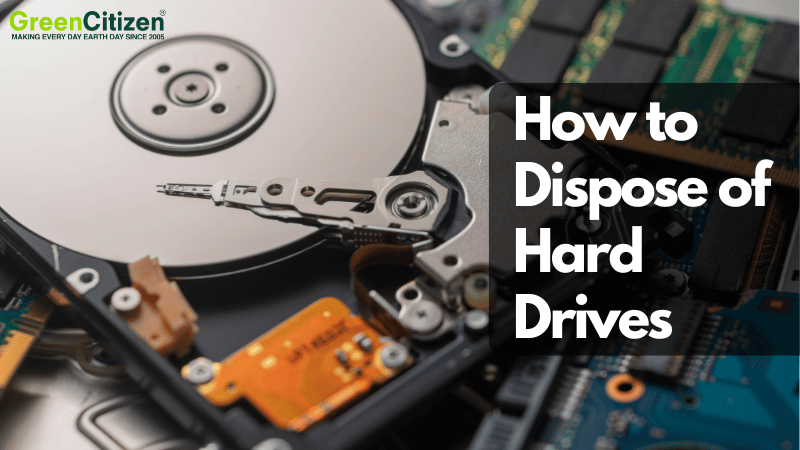How do you know your data is truly gone?
That’s the question that keeps people up at night when disposing of old hard drives. Whether it’s financial records, business contracts, or personal photos, sensitive data lingers even after deletion.
Simply erasing files, formatting the drive, or even smashing it with a hammer doesn’t mean your information is unrecoverable.
Data theft is a massive concern.
Cybercriminals and data scavengers actively look for improperly discarded hard drives, and you’d be shocked at how easy it is to recover data from them.
In fact, a Blancco study in 2016 found that 67% of used hard drives sold online still contained recoverable data—including tax documents, passwords, and personal files.
For businesses, the stakes are even higher.
Regulatory laws like GDPR and CCPA impose strict penalties for failing to properly dispose of data. A single hard drive in the wrong hands can lead to identity theft, corporate espionage, or massive data breaches.
So, how do you ensure your hard drive is 100% destroyed, leaving zero chance of recovery? This blog will break down the most secure ways to dispose of hard drives—from shredding and degaussing to secure data wiping.
Plus, we’ll explore how GreenCitizen provides a certified and eco-friendly solution to guarantee your sensitive data never falls into the wrong hands.
Key Takeaways: What Is The Safest Way To Dispose of Hard Drives
The safest way to dispose of hard drives is through certified destruction methods like shredding, degaussing, or crushing. Simply deleting files or formatting won’t protect your data. Use a professional hard drive disposal service that follows NIST 800-88 standards for secure, permanent, and eco-friendly data destruction and recycling.
Why Secure Hard Drive Disposal Matters: An Example
Imagine waking up to find that your medical history, Social Security number, and financial details are floating around the dark web—all because of a discarded hard drive.
It sounds like a nightmare—but for over 100,000 patients of HealthReach Community Health Centers, it became a harsh reality.
The High Stakes of Data Theft
Failing to destroy hard drives properly isn’t just a technical oversight—it’s a serious security risk with devastating consequences.
Data theft can lead to:
- Financial loss – Stolen banking details and identity fraud can drain accounts in minutes.
- Reputational damage – Businesses can lose customer trust overnight.
- Legal penalties – Laws like GDPR, CCPA, and HIPAA mandate strict data protection rules, and violations come with heavy fines.
And it’s not just a hypothetical risk—it happens more often than you think.
HealthReach’s Costly Mistake: A Hard Drive Disposal Horror Story
On September 9, 2021, HealthReach Community Health Centers discovered a major healthcare data breach. Over 101,000 patients in Maine—plus another 15,000+ across other states—were put at risk because a third-party storage facility failed to properly dispose of hard drives.
Instead of being wiped, shredded, or securely destroyed, these hard drives ended up where they shouldn’t have.
Inside them?
Patient names, Social Security numbers, medical records, insurance details, passwords, financial data, and even PINs. Everything cybercriminals need to steal identities, commit fraud, and sell private information on the dark web.
Though no fraudulent activity had been detected (yet), the damage was done. HealthReach had to scramble to contain the fallout, offering free credit monitoring, identity theft protection, and $1 million reimbursement insurance for every affected patient.
And they weren’t alone.
1 in 4 data breaches stems from negligence, and in 2020 alone, improper disposal of electronics led to 600,000+ records being exposed.
The lesson?
Deleting files or storing old hard drives in a locked cabinet isn’t enough. Without a secure destruction method, sensitive data remains vulnerable—sometimes for years.
7 Ways to Destroy a Hard Drive
Not all data destruction methods are created equal.
Some ensure permanent, irreversible destruction, while others only erase data at the software level—leaving it vulnerable to skilled recovery attempts.
Let’s break it down:
1. Shredding (Physical Destruction Method)
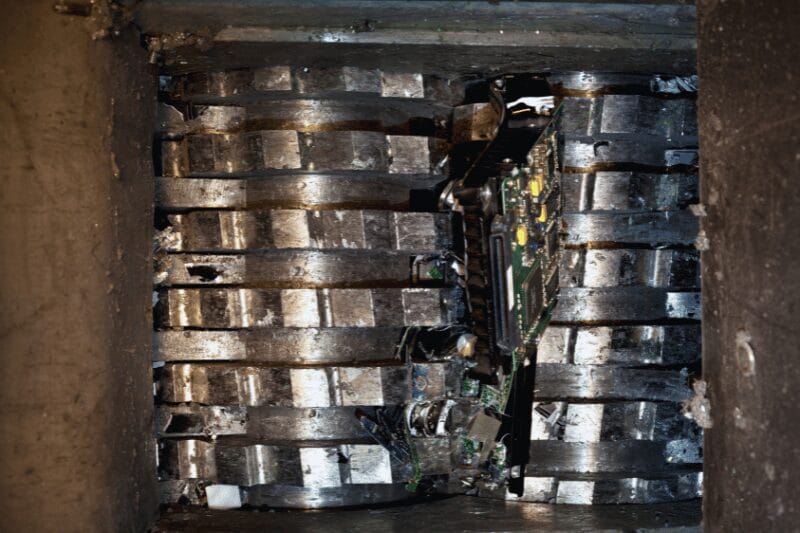
Best for: Businesses, government agencies, high-security data destruction.
Shredding is the gold standard for hard drive disposal. Industrial-grade shredders pulverize hard drives into tiny, confetti-sized pieces, making data recovery completely impossible.
This method follows the NIST 800-88 R1 guidelines, ensuring compliance with GDPR, CCPA, HIPAA, and other data protection laws.
Pros
Cons
- 100% effective—no chance of data recovery.
- Fast and scalable for bulk destruction.
- Meets strict regulatory compliance standards.
- Requires access to a professional hard drive destruction service.
- Not a DIY-friendly option.
2. Degaussing (Data Wiping Method)
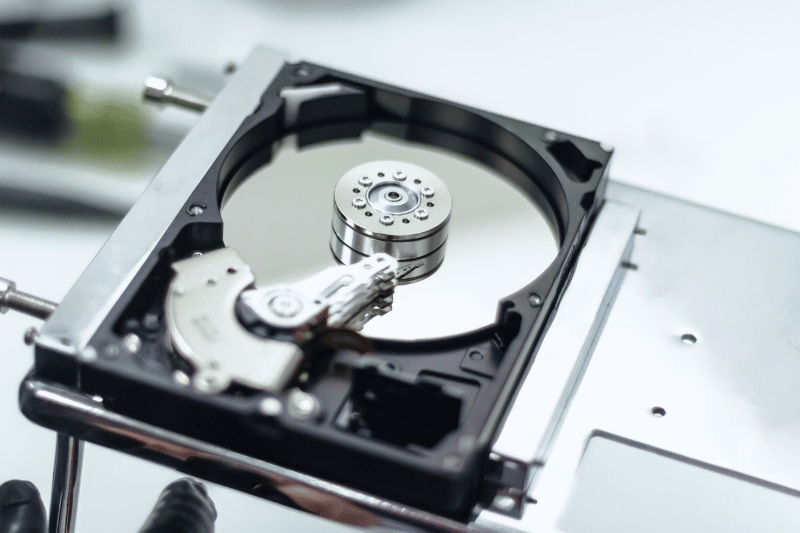
Best for: Organizations handling classified data, banks, healthcare providers.
Degaussing uses an extremely powerful magnet to scramble a hard drive’s data, rendering it permanently unreadable. It works by disrupting the magnetic fields storing digital information, effectively wiping the data beyond recovery.
Pros
Cons
- Fast and effective for HDDs.
- Approved by NSA and DoD standards.
- Doesn’t work on SSDs—solid-state drives store data differently.
- The process also destroys the firmware, making the drive completely unusable.
- Degaussing machines are expensive and not easily accessible for individuals.
3. Crushing (Physical Destruction Method)
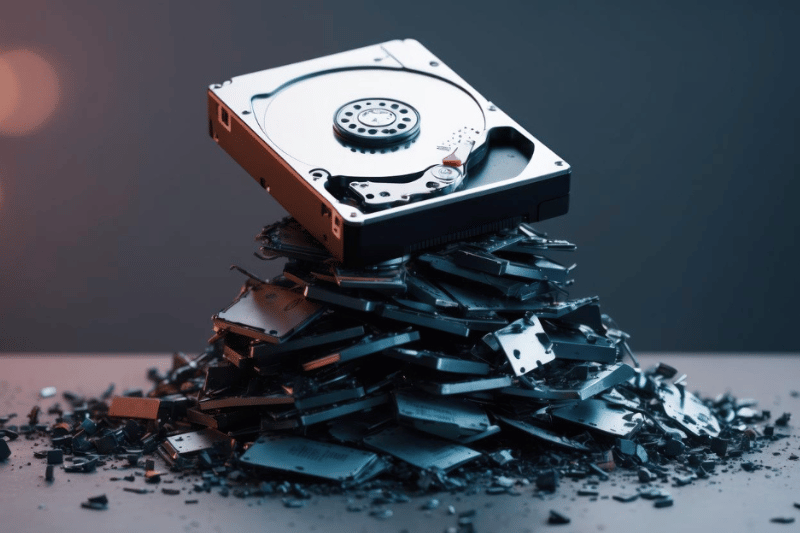
Best for: Military, government agencies, secure business environments.
Crushing and milling use heavy machinery to physically destroy a hard drive, breaking the platters into small fragments or puncturing them. Some crushers apply thousands of pounds of force to bend and crack the drive, while milling drills a hole through the platters, making data recovery impossible.
Pros
Cons
- One of the most secure methods—widely used by certified destruction services.
- Leaves no recoverable data when done properly.
- Requires specialized equipment.
- Not a DIY-friendly option.
4. Data Wiping / DBAN / Encryption (Software-Based Erasure)
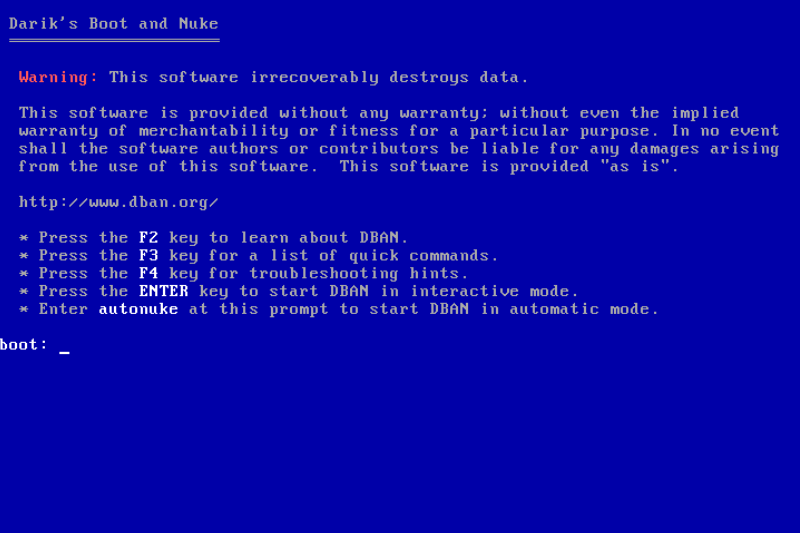
Best for: Individuals and businesses that want to reuse or donate hard drives.
Software-based data erasure methods like DBAN (Darik’s Boot and Nuke) or Full Disk Encryption (FDE) overwrite existing data with random 1s and 0s multiple times. Encryption, when properly implemented, makes data unreadable without the encryption key.
Pros
Cons
- Allows for reuse or resale of hard drives.
- Free or low-cost option.
- Not foolproof—a determined hacker may still recover fragments of data.
- Takes hours for larger drives.
- Must be done correctly—one missed step can leave data vulnerable.
- DBAN doesn't work on SSDs
5. Hammer / Shattering (DIY Physical Destruction Method)
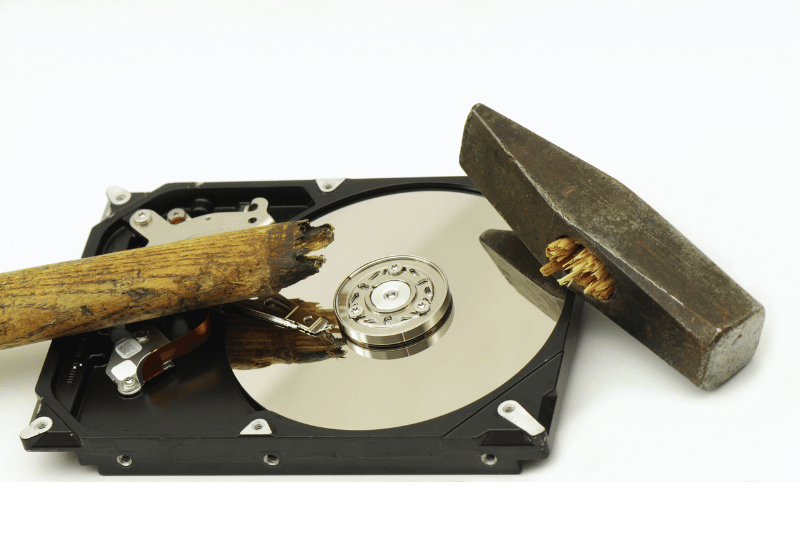
Best for: Individuals looking for a quick, no-cost method (but not the most effective).
Taking a hammer to a hard disk sounds satisfying, but it’s far from secure. Unless the platters are completely shattered, data can still be recovered using specialized techniques. Plus, shards of glass and metal can fly everywhere, making it potentially dangerous.
Pros
Cons
- Cheap and accessible—no special equipment needed.
- Highly unreliable—data can still be recovered from undamaged sections.
- Risk of injury from flying debris.
- Time-consuming—drives are built to withstand impact.
6. Drilling ( DIY Physical Destruction Method)
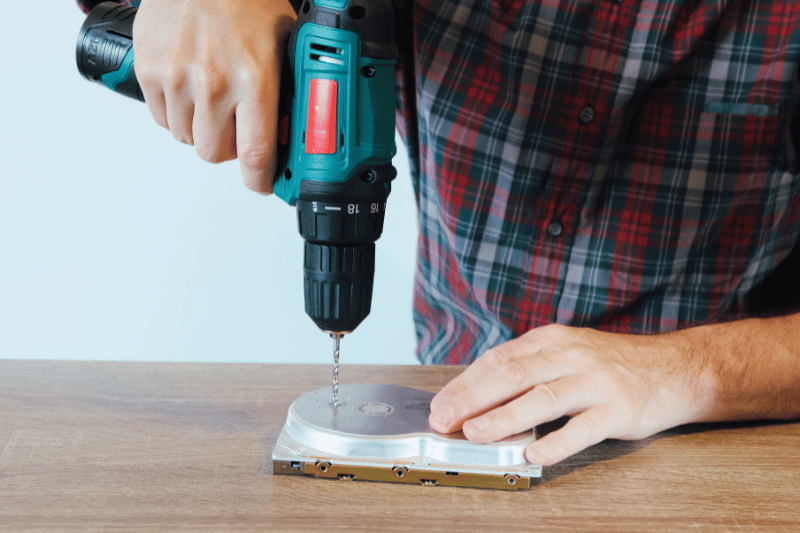
Best for: DIY users with access to power tools.
Drilling holes through a hard drive’s platters can destroy data to some extent. However, if even a small portion of the platter remains intact, data recovery is still possible. Additionally, drill bits wear out after a few uses, making this a costly and inefficient method over time.
Pros
Cons
- A better DIY option than hammering.
- Faster than smashing a hard drive to bits.
- Not 100% secure—small undamaged sections may still contain data.
- Drill bits can break if the drive is too tough.
7. Incineration / Melting (Physical Destruction Method)
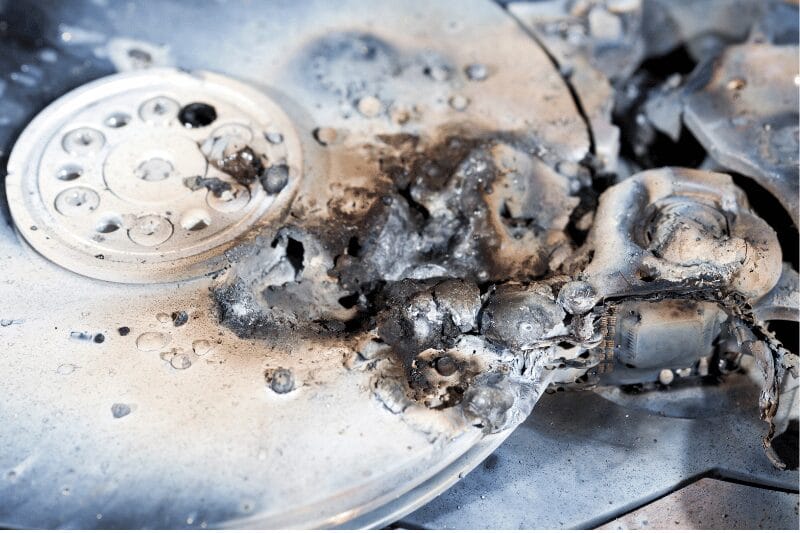
Best for: Absolute data annihilation—but requires extreme heat.
Exposing a hard drive to temperatures above 2,000°F completely melts the platters, ensuring permanent data destruction. This method is recognized by NIST 800-88 R1 as an approved data destruction technique.
However, burning electronics releases toxic fumes and should only be performed by licensed disposal facilities.
Pros
Cons
- Completely irreversible—rendering data unrecoverable.
- Ideal for high-security needs.
- Environmentally hazardous—burning releases harmful chemicals.
- Not a DIY option—requires industrial-grade incinerators.
Hard Drive Destruction Methods Summarized
| Method | Effectiveness | Time Needed | Method | DIY or Pro |
|---|---|---|---|---|
| Shredding | 100% - No recovery possible | Fast (seconds) | Physical Destruction | Pro |
| Degaussing | High - Data erased permanently | Fast (instant) | Data Erasure | Pro |
| Crushing | 100% - Platters broken/punctured | Fast | Physical Destruction | Pro |
| Data Wiping (DBAN/Encryption) | Moderate - May be recoverable | Slow (hours) | Physical Destruction | DIY |
| Hammer/Shatter | Low - Not fully reliable | Slow | Physical Destruction | DIY |
| Drilling | Medium - Small sections intact | Moderate | Physical Destruction | DIY |
| Incineration/Melting | 100% - Total destruction | Fast (instant) | Physical Destruction | Pro |
How GreenCitizen Handles Hard Drive Disposal
At GreenCitizen, every step of the process—from collection to destruction—is designed for maximum security, compliance, and sustainability. One of the key factors that sets us apart is GTAMS—our proprietary tracking and accountability system that ensures safety and compliance at every stage.
Handling hundreds of HDDs and SSDs daily, GreenCitizen ensures that no data is left behind while keeping electronic waste out of landfills.
Streamlined Collection: Overcoming Urban Logistics
GreenCitizen dispatches a fleet of trucks for daily pickups, with each vehicle making multiple stops across the San Francisco Bay Area.
However, logistics come with challenges.
Many businesses have offices in tall buildings, often with hard drives stored in different locations. Our team must visit each location and collect the hard drives, requiring extra time and effort to bring them down.
Sometimes, we also face issues with elevator access.
Parking is another hurdle, especially in a bustling region like the San Francisco Bay Area. Our trucks cannot remain in the same location for extended periods.
Despite these challenges, GreenCitizen collects thousands of HDDs and SSDs every month, discreetly transporting them in Gaylord bins to streamline the sorting process.
GreenCitizen also offers onsite data destruction services. We understand that some businesses prefer onsite hard disk destruction due to handling sensitive data. If you require this specialized service, please let us know, and we will arrange it for you.
GreenCitizen's Unique HDD/SSD Sorting and Tracking Process
Once the hard drives and SSDs arrive at GreenCitizen’s facility, they go through a detailed sorting and tracking process.
- Each drive is manually counted and cross-checked against the expected count.
- If there’s a discrepancy, GreenCitizen contacts the customer immediately.
- Every device’s serial ID, make, and model are logged into GTAMS (GreenCitizen Total Accountability Management System) for full traceability.
Sorting and logging HDD tracking data takes about three to five minutes per drive. On the other hand, laptop and server HDDs/SSDs take much longer as we have to manually disassemble them and collect the HDDs inside.
Especially servers, as they have multiple HDDs inside.
Data Erasure and Physical Destruction
GreenCitizen offers two secure data destruction options:
1. Data Erasure (NIST 800-88 Compliant)
- For $5 per device, customers can choose data sanitization following NIST 800-88 Rev.1 guidelines.
- This method ensures complete data erasure, making the drive safe for reuse.
2. Physical Destruction
- GreenCitizen uses industrial-grade pneumatic HDD Crushers to shatter and puncture HDDs.
- These crushers apply 12,000 pounds (490K PSI) of force, delivering catastrophic damage to the drive chassis while completely destroying the internal platter.
- Since SSDs store data differently, they are drilled through for secure destruction.
- These methods guarantee that data cannot be recovered, even by the most advanced forensic tools.
- The destroyed drives are then sent to certified downstream vendors for melting and material recovery, ensuring an eco-friendly disposal process.
Why Locked Devices Are a Problem for Recyclers
While data destruction is critical, device locks pose an entirely different challenge. Especially, MacBook’s EFI lock particularly creates a problem for reuse enthusiasts.
If the MacBook has an EFI lock enabled, it means that certain hardware-level security measures are in place.
Why Does This Matter?
The circular economy encourages reuse over disposal, maximizing an item’s lifespan.
However, when a MacBook is locked, we cannot sanitize the HDD/SSD. If it were unlocked, we could repair or refurbish it for reuse. Instead, our only option is to dismantle and recover materials, wasting an otherwise reusable device.
For GreenCitizen, this is a significant loss.
As strong advocates of the circular economy, the goal is always to refurbish and extend the life of electronics whenever possible. Locked devices eliminate that opportunity, forcing otherwise reusable tech into the recycling stream.
4 Mistakes to Avoid When Disposing of Hard Drives
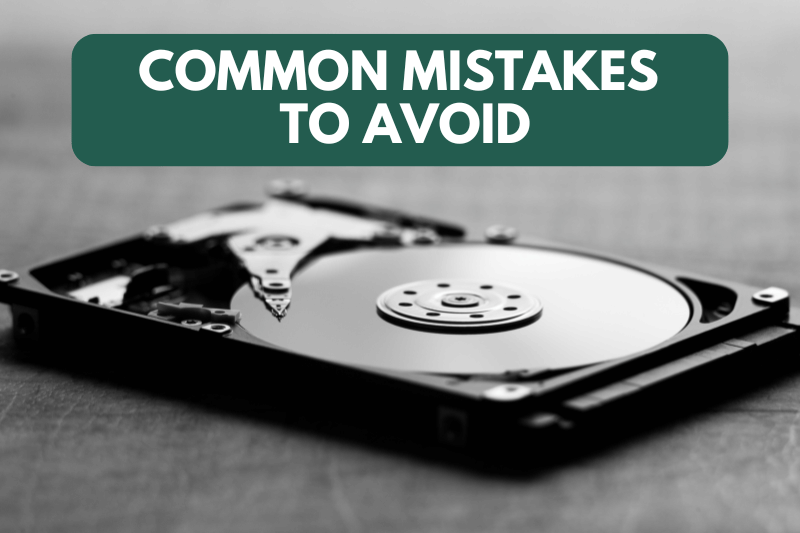
Why Deleted Files Are Not Really Gone
Many people assume that once they delete a file, their sensitive information is gone forever. You can see the available storage increase, and even overwrite the space with new data—so how can hackers still retrieve old files?
Here’s how our computers “delete data!”
When you delete a file, your hard drive doesn’t actually remove the private data. Instead, the operating system marks the space as “available” for new data. Until new information completely overwrites every bit of the old file, it still exists on the platter surfaces.
Even after filling your old hard drive with new data, fragments of the original files remain scattered across the disk.
Hackers and forensic experts use specialized software to scan electronic media and recover data from these leftover traces. That’s why simply deleting files, formatting the drive, or reinstalling an operating system does not make data unrecoverable.
Let’s look at some of the biggest mistakes people make when trying to securely dispose of an old computer or hard drive.
1. Thinking Magnets Will Erase Data
A common myth is that a magnet can wipe a hard drive. While industrial degaussers work on HDDs, household magnets won’t. Plus, degaussing doesn’t work on SSDs, which store data electronically.
2. Simply Formatting the Drive
Formatting removes file paths, not the data itself. Recovery tools can still retrieve files, even after multiple formats.
3. Destroying It the Wrong Way
Hammering, drilling, or smashing a hard drive may leave recoverable data intact. Plus, shattered parts can be dangerous.
4. Recycling Without Proper Data Destruction
Recycling without securely wiping data risks unauthorized access. Some recyclers refurbish and resell parts, potentially exposing your information.
Why Hire a Professional Hard Drive Destruction Service?
Destroying a hard drive isn’t as simple as smashing it or running a magnet over it. Simply deleting files or formatting doesn’t make data disappear.
The only way to ensure your sensitive information is permanently erased is through a certified destruction service.
Guaranteed Security: No Loose Ends
Would you toss your Social Security number in the trash? That’s what happens when a hard drive isn’t properly destroyed.
Professional services ensure:
- Tamper-proof tracking – Every drive is monitored from collection to destruction.
- Certified destruction – Shredding, degaussing, or crushing makes data irrecoverable.
- Certificate of Destruction (CoD) – Proof your data is permanently erased.
Once a drive leaves your hands, you lose control over where it ends up. A professional service guarantees it stays out of the wrong hands.
Legal Compliance: Avoid Costly Mistakes
Ignoring data disposal laws can lead to massive fines. Regulations like NIST 800-88, HIPAA, GDPR, and CCPA require secure disposal of sensitive data.
A certified service ensures compliance, protecting businesses from lawsuits and financial penalties.
Eco-Friendly Disposal: Security Meets Sustainability
Simply tossing hard drives into recycling bins is a mistake—data can still be recovered. Professional services offer:
- Zero-landfill recycling – Hard drives are shredded, and valuable metals are recovered.
- Safe disposal of toxic materials – Preventing environmental harm.
Cost-Effective: Cheaper Than a Data Breach
A DIY approach seems cheaper, but a single data breach can cost millions in fines, lawsuits, and lost trust. Professional destruction eliminates this risk at a fraction of the cost—and takes just minutes.
Frequently Asked Questions (FAQ)
Not necessarily. While a hammer can physically damage the drive, data can still be recovered unless the platters inside are completely shattered. A more secure method is using an industrial crusher or shredding the drive.
No. Water alone won’t erase data, and a soaked hard drive can still be recovered with advanced techniques. If security is a concern, you need to physically destroy the platters or use certified data-wiping methods.
Drilling a hole may damage the drive, but data can still be recovered from the remaining platters. For complete destruction, multiple holes should be drilled, or the platters should be shattered or shredded.
No, and it’s dangerous. Microwaving a hard drive can cause sparks, toxic fumes, and even a fire, but it won’t guarantee complete data destruction. A professional destruction method is far safer and more effective.
Burning a hard drive can damage it, but it needs extreme heat to fully destroy the platters. Household fires usually don’t reach the temperatures needed, making this an unreliable method.
It’s a good idea if you’re concerned about data security. However, professional recyclers offer certified data destruction, which ensures your data is erased properly before recycling the materials.
Yes. Using data-wiping software that follows NIST 800-88 standards ensures complete erasure. If you want extra security, physical destruction—like shredding or crushing—is the best option.
The Right Hard Drive Recycler Makes All the Difference
Not all hard drive recyclers are the same. Some claim to handle data destruction responsibly, but without clear protocols and certifications, there’s no way to know if your hard drive is actually destroyed—or if your sensitive data could end up in someone else’s hands.
When choosing a hard drive recycling service, ask questions.
- Do they provide a Certificate of Destruction?
- Do they follow NIST 800-88 guidelines?
What happens to the drive after destruction? A reputable recycler will have transparent answers. If they don’t, that’s a red flag.
DIY methods might seem like a quick fix, but if security is your priority, hammering or drilling a hard drive simply isn’t enough. Even when drives look physically damaged, forensic recovery tools can still extract data from undamaged platter surfaces. If you store financial records, medical documents, or business information, trusting a professional data destruction service is the only way to guarantee your data is gone forever.
If you’re in the San Francisco Bay Area, GreenCitizen provides secure, certified hard drive disposal with zero-landfill recycling. For those outside the region, GreenCitizen’s nationwide mail-in recycling program ensures that anyone in the USA can safely dispose of old hard drives without the risk of data breaches.
Contact GreenCitizen today and make sure your private data stays private.
